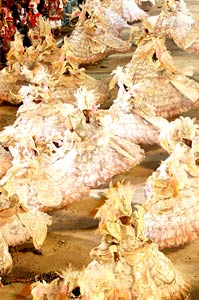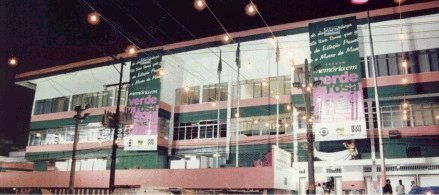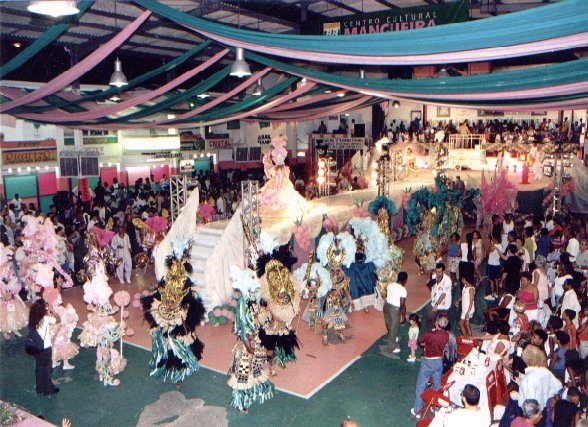Carnival
in Rio de Janeiro
The
Samba Schools
© Mangueira
Understanding
what a samba school is can be confusing if someone has never
been to Rio and isn't familiar with its carnival. Samba schools
are not teaching institutions, they are associations of people
who live in the same neighborhood, usually a popular community,
or slums ("favela"), or a suburban area. They get together
on a regular basis for samba meetings and rehearsals and to create
the costumes, floats, and all other accessories that are used
in the carnival parade. "Although today's samba schools
are comprised of people from all races and social classes, they
remain vital strongholds of Afro-Brazilian culture."
 Each samba school has its own
colors and a flag. The colors of Mangueira, the most famous samba
school in Rio, are green and pink.
"Since
their beginning in 1928, the samba schools (escolas de samba)
have been an integral part of Rio's Carnaval and have evolved
into a grand spectacle, an overwhelming experience for both participants
and observers."
The
first samba school to be known of, "Deixa Falar" (Let
Them Talk), was founded in a neighborhood in Rio named Estácio
on August 12, 1928. "Apparently, the name "samba school"
was an ironic reference to a grade school across the street from
where the group met. "Deixa Falar" was more like a
club or a fraternity, dedicated to making music and parading
during Carnaval.
On
April 28, 1929, a group of people formed the samba school that
ultimately proved to be the most traditional and longest-lived
of them all: "Estação Primeira de Mangueira"
(Number-One Station of Mangueira), whose founders included the
famous composers Cartola and Carlos Cachaça."
Mangueira
is the name of a neighborhood and a hill in the north of Rio
de Janeiro. In the beginning of the century, Mangueira already
had a good reputation as a samba place. In 1927, José
Gomes da Costa, known as Zé Espinguela, suggested that
him and his friends should create a "bloco" (a carnival
group), and so the "Bloco dos Arengueiros" was born.
The "sambistas" (people who make samba) from the "Bloco
dos Arengueiros" had such prestige that they decided it
was time to found a samba school and Cartola suggested that all
carnival groups in Mangueira united to form a samba school. Then
the "Bloco dos Arengueiros" and other "blocos"
from Mangueira, such as the "Príncipe da Floresta"
(Prince of the Forest, the most famous carnival group from Mangueira),
among others, joined to form the "Estação
de Primeira de Mangueira" Samba School, on April 28, 1928.
Cartola
chose the name of the school, "Estação Primeira
de Mangueira" and suggested that the colors green and pink
should be the official colors of the samba school. These were
the same colors of a carnival group named "Rancho dos Arrepiados",
a group from Cartola's childhood carnivals. Some people say that
Cartola chose the name "Estação Primeira de
Mangueira" because Mangueira was the first train station
departing from the Central Station. Others say that Mangueira
was the second (São Cristóvão station was
the first) and the reason why Cartola chose the name "Estação
Primeira" was because at that time, a neighborhood was referred
to as "estação" (station) and Mangueira
was, in his opinion, the best "estação",
the number one ("primeira"), thus the name "Estação
Primeira de Mangueira" (Number-One Station of Mangueira).
In
1929, Zé Espinguela, one of the founders of Mangueira,
promoted the first confrontation among the samba schools at Praça
Onze, in downtown Rio. He was the the only jury and there were
only three samba schools at that time. Mangueira was the winner.
"In 1932, the parade became official and Mangueira received
its first award. In 1935, mayor Pedro Ernesto officialy incorporated
the samba school parade to the city's calendar."
In
the same year, Paulo da Portela (Paulo Benjamim de Oliveira),
Heitor dos Prazeres and others inaugurated "Portela",
formerly named "Vai como pode". Portela was the most
innovative of the samba schools for many decades. "It has
been responsible for setting most of patterns that the others
have followed. Its founder, Paulo da Portela, and his associates
introduced into the parade such now obligatory items as the "enredo"
(theme), the "commisão de frente" (front commission),
and the "carros alegóricos" (decorated floats)."
The
samba school parade was officially recognized by the government
in 1935 and the samba, that until that time was played in Spanish
guitars and "cavaquinhos", was introduced to percussion
instruments such as "surdos" and "cuícas"
and the modern samba was born. The parades, that used to happen
at Praça Onze Square, located in downtown Rio, moved to
Rio Branco Avenue (a large avenue also located downtown). In
1984, the Marquês de Sapucaí Avenue, known as "sambódromo",
an avenue built specifically for the carnival parades, was created.
In
1952, the samba schools started to be divided in groups. Today,
there are two major groups, the first one is called "Grupo
Especial" (Especial Group) which is affiliated to LIESA
(Liga Independente das Escolas de Samba) and the "Grupo
de Acesso" (Access Group) which is affiliated to the AESCRJ
(Associação das Escolas de Samba do Rio de Janeiro)
and is divided into 5 other sub-groups called groups A, B, C,
D and E.
Every
year, the 14 samba schools of Rio that are part of the Especial
Group, present their parade during two days of carnival (always
a Sunday and a Monday) . Seven samba schools perform on Sunday
and the other seven perform on Monday. The samba schools from
the other groups (A, B, C, D and E), perform on Friday, Saturday
and Tuesday.
The
parade, apart from the entertainment and spectacle, is a competition
between the samba schools. They are judged during the parade
and only one samba school will be chosen as the Carnival champion.
The jury gives grades from one to ten for "samba-enredo"
(samba theme song), "comissão de frente" (front
comission), "mestre-sala and porta-bandeira" (standard
bearer and the escort), costumes, "evolução"
(dance performance of the escola), "bateria" (percussion)
etc. Each school has a limited time to begin and end its parade
on the avenue. The samba schools from the Especial Group have
a maximum of 80 minutes to perform. If a school exceeds this
amount of time, it looses points.
The
results are are announced to the public live from the "sambódromo"
on the Ash-Wednesday (day that follows the last day of carnival).
The winning school celebrates in its headquarters, stretching
Carnaval for one more night.
© O Globo Each samba school has its own
colors and a flag. The colors of Mangueira, the most famous samba
school in Rio, are green and pink.
"Since
their beginning in 1928, the samba schools (escolas de samba)
have been an integral part of Rio's Carnaval and have evolved
into a grand spectacle, an overwhelming experience for both participants
and observers."
The
first samba school to be known of, "Deixa Falar" (Let
Them Talk), was founded in a neighborhood in Rio named Estácio
on August 12, 1928. "Apparently, the name "samba school"
was an ironic reference to a grade school across the street from
where the group met. "Deixa Falar" was more like a
club or a fraternity, dedicated to making music and parading
during Carnaval.
On
April 28, 1929, a group of people formed the samba school that
ultimately proved to be the most traditional and longest-lived
of them all: "Estação Primeira de Mangueira"
(Number-One Station of Mangueira), whose founders included the
famous composers Cartola and Carlos Cachaça."
Mangueira
is the name of a neighborhood and a hill in the north of Rio
de Janeiro. In the beginning of the century, Mangueira already
had a good reputation as a samba place. In 1927, José
Gomes da Costa, known as Zé Espinguela, suggested that
him and his friends should create a "bloco" (a carnival
group), and so the "Bloco dos Arengueiros" was born.
The "sambistas" (people who make samba) from the "Bloco
dos Arengueiros" had such prestige that they decided it
was time to found a samba school and Cartola suggested that all
carnival groups in Mangueira united to form a samba school. Then
the "Bloco dos Arengueiros" and other "blocos"
from Mangueira, such as the "Príncipe da Floresta"
(Prince of the Forest, the most famous carnival group from Mangueira),
among others, joined to form the "Estação
de Primeira de Mangueira" Samba School, on April 28, 1928.
Cartola
chose the name of the school, "Estação Primeira
de Mangueira" and suggested that the colors green and pink
should be the official colors of the samba school. These were
the same colors of a carnival group named "Rancho dos Arrepiados",
a group from Cartola's childhood carnivals. Some people say that
Cartola chose the name "Estação Primeira de
Mangueira" because Mangueira was the first train station
departing from the Central Station. Others say that Mangueira
was the second (São Cristóvão station was
the first) and the reason why Cartola chose the name "Estação
Primeira" was because at that time, a neighborhood was referred
to as "estação" (station) and Mangueira
was, in his opinion, the best "estação",
the number one ("primeira"), thus the name "Estação
Primeira de Mangueira" (Number-One Station of Mangueira).
In
1929, Zé Espinguela, one of the founders of Mangueira,
promoted the first confrontation among the samba schools at Praça
Onze, in downtown Rio. He was the the only jury and there were
only three samba schools at that time. Mangueira was the winner.
"In 1932, the parade became official and Mangueira received
its first award. In 1935, mayor Pedro Ernesto officialy incorporated
the samba school parade to the city's calendar."
In
the same year, Paulo da Portela (Paulo Benjamim de Oliveira),
Heitor dos Prazeres and others inaugurated "Portela",
formerly named "Vai como pode". Portela was the most
innovative of the samba schools for many decades. "It has
been responsible for setting most of patterns that the others
have followed. Its founder, Paulo da Portela, and his associates
introduced into the parade such now obligatory items as the "enredo"
(theme), the "commisão de frente" (front commission),
and the "carros alegóricos" (decorated floats)."
The
samba school parade was officially recognized by the government
in 1935 and the samba, that until that time was played in Spanish
guitars and "cavaquinhos", was introduced to percussion
instruments such as "surdos" and "cuícas"
and the modern samba was born. The parades, that used to happen
at Praça Onze Square, located in downtown Rio, moved to
Rio Branco Avenue (a large avenue also located downtown). In
1984, the Marquês de Sapucaí Avenue, known as "sambódromo",
an avenue built specifically for the carnival parades, was created.
In
1952, the samba schools started to be divided in groups. Today,
there are two major groups, the first one is called "Grupo
Especial" (Especial Group) which is affiliated to LIESA
(Liga Independente das Escolas de Samba) and the "Grupo
de Acesso" (Access Group) which is affiliated to the AESCRJ
(Associação das Escolas de Samba do Rio de Janeiro)
and is divided into 5 other sub-groups called groups A, B, C,
D and E.
Every
year, the 14 samba schools of Rio that are part of the Especial
Group, present their parade during two days of carnival (always
a Sunday and a Monday) . Seven samba schools perform on Sunday
and the other seven perform on Monday. The samba schools from
the other groups (A, B, C, D and E), perform on Friday, Saturday
and Tuesday.
The
parade, apart from the entertainment and spectacle, is a competition
between the samba schools. They are judged during the parade
and only one samba school will be chosen as the Carnival champion.
The jury gives grades from one to ten for "samba-enredo"
(samba theme song), "comissão de frente" (front
comission), "mestre-sala and porta-bandeira" (standard
bearer and the escort), costumes, "evolução"
(dance performance of the escola), "bateria" (percussion)
etc. Each school has a limited time to begin and end its parade
on the avenue. The samba schools from the Especial Group have
a maximum of 80 minutes to perform. If a school exceeds this
amount of time, it looses points.
The
results are are announced to the public live from the "sambódromo"
on the Ash-Wednesday (day that follows the last day of carnival).
The winning school celebrates in its headquarters, stretching
Carnaval for one more night.
© O Globo
Beija-Flor's "quadra"
and its members celebrating
the championship of Canival 2003
Each
carnival, one school from the Especial Group descends to group
A and one school from the group A ascends to the Especial group.
This happens to all other groups too. Schools from the group
A descend to group B, schools from the group B ascend to group
A, schools from group B descend to group C, and so on. This way
every school has the chance to get to the Especial group one
day.
 |
The
Parade
© Mangueira
Marquês
de Sapucaí Avenue - Carnival 2000 |
The
Marquês de Sapucaí Avenue, popularly knonwn as "sambódromo",
(or samba avenue), located in downtown Rio, was created in 1984
to be the place for the samba schools to present their show.
Designed by the famous architect Oscar Niemeyer, it is a seven-hundred-meter-long
pathway flanked by concrete stands that seat ninety thousand
people. |
|
At
its end is the huge, aptly named Praça da Apoteose (Apotheosis
Square). But the avenue is only part of the whole "sambódromo"
which occupies a very large area.
|
|
|
The
first school to perform on the samba avenue was the "Império
do Marangá". Before the construction of the "sambódromo",
the samba schools performed on Rio Branco Avenue.
On the right you can see Império
Serrano's standard bearer and the master of ceremonies, during
a parade at Rio Branco Avenue in 1968. |
|
"Mounting
samba school parade is a vast undertaking that involves tens
of thousands of people, including musicians, dancers, craftsmen,
costume-makers, and other contributors, but its basic format
is always the same. To begin with, every parade must have a theme,
the "enredo", which might be political or historical
or a tribute to a particular person. Until 1996 the enredo had
to be related to Brazil. It is chosen by the "carnavalesco",
a type of art director who is responsible for the visual aspect
of the escola. After the "enredo" is approved by the
board of directors, the "carnavalescos" of each school
write a synopsis of it, describing the message they want to visually
convey in the parade. Then, around June, the synopsis is distributed
among the school's composers so that they can begin writing sambas
on the theme. Such a samba is called a "samba-enredo"
(samba theme song).
When
the composers have their sambas ready, they submit them to the
directors, who choose the best ones. Around August, rehearsals
begin in the school's headquarters, where musicians play old
sambas and the contending "sambas-enredos". The reaction
of the members to the new sambas will be decisive in the picking
of the "samba-enredo" for the parade. On a certain
night, usually at the end of October, the school chooses the
winner from the finalists.
After
a school's "samba-enredo" is chosen, all energy is
focused on preparations and rehearsals for the parade. By this
time, the "carnavalesco" has already designed and ordered
the costumes for the "alas" — the parade units
into which samba schools are divided. Each "ala" wears
a different costume and plays a specific part in the development
of the theme. |
|
In
between "alas" come the "carros alegóricos"
— huge decorated floats that depict important aspects of
the "enredo" (theme). These floats are true pieces
of art, mixtures of sculpture, architecture, and engineering.
On top of them stand the "destaques" — men and
women wearing either luxurious, expensive costumes or almost
nothing at all. The making of the floats employs hundreds of
people. |
© Liesa
Two of the floats
and some "alas" of the Caprichosos de
Pilares Samba School on the Marquês de Sapucaí Avenue. |
© Liesa
"Ala"
of the Unidos da Tijuca's Samba School
at the "sambódromo" on March, 6 2005. |
Each
big school typically has from four thousand to more than five
thousand members who perform in its parade. To organize this
many people is extremely complicated. That is what the "diretores
de harmonia" (harmony directors) are for. They do not have
fun. They just work. Hours before the school enters the Sambódromo,
the harmony director begins organizing the parade in an outside
area, the "concentração" (concentration),
putting the arriving "ala" members in their proper
places and setting all the "alas" in the right order." |
|
A
few minutes before the parade begins and the "alas"
start to enter the samba avenue, the "puxador de samba"
(name given to the main singer of a samba school), who comes
on top of the sound float, begins to sing the samba theme song.
Slowly the members of the school start singing with him. |
© Portal Terra
Jamelão
(wearing a hat) - Mangueira's main singer
on top of the sound float on March, 3 2003 |
© Globo.com
"Bateria"
of the Império Serrano's Samba School
on the "sambódromo" on March, 2 2003 |
"After
the whole school has sung the samba one or two times without
accompaniment, the most exciting moment in the parade preparation
occurs: the musical entrance of the "bateria" (the
percussion band). Some three hundred percussionists under the
command of the "mestre de bateria" (percussion conductor)
start playing perfectly." |
|
"Right
before the gates open and the clock starts running, fireworks
explode in the air. The "comissão de frente"
(front comission) steps into the Sambódromo, greeting
people and asking permission to pass.
The
bateria follows the first half of the escola into the passarela.
They pass in front of thousands of spectators, and along the
way come to a space set off to the side for the bateria to play
in front of the jury. There, the drummers and percussionists
play before the judges, while the second half of the escola passes.
Then, the bateria, following the last "ala", closes
the parade. By this time the next escola is preparing to enter
the Sambódromo." |
© Globo.com
The Marquês
de Sapucaí Avenue seen from the
Apoteose Square and the fireworks - March, 2 2003 |
© Portal Terra
Standard-bearer
and the Master of Ceremonies from
Imperatriz Leopoldinense Samba School - March 3, 2003 |
Some
of the most important individuals in the schools are the "porta-bandeira"
(standard-bearer), who is always a woman and her escort, the
"mestre-sala" (the male master of ceremonies, who accompanies
her). "Dancing elegantly, the porta-bandeira carries the
escola flag, while the mestre-sala dances around her, providing
symbolic protection." |
|
Not
less important are the "baianas", normally old women
from the community who dress in typical costumes for the parade.
They are very acclaimed by the public when they come whirling
with their long, heavy and round dresses along the avenue. It
is very beautiful, especially seen from above. |
© Portal Terra
Baianas from Viradouro
Samba School
March 2, 2003 |
 The baianas are
typical figures of Bahia. A baiana is how a woman from Bahia
(a state in northern Brazil) is called. A typical baiana always
wears a white dress and a turbant on special occasions or festivities.
They are represented in all samba schools in Rio by women on
baiana outfits, which are created accordingly to the theme of
the school. The baianas are
typical figures of Bahia. A baiana is how a woman from Bahia
(a state in northern Brazil) is called. A typical baiana always
wears a white dress and a turbant on special occasions or festivities.
They are represented in all samba schools in Rio by women on
baiana outfits, which are created accordingly to the theme of
the school. |
© Portal Terra
Baianas from Mangueira
Samba School
March 3, 2003 |

|
The
rehearsals for Carnival
The
rehearsals of all samba schools are open to the public and take
place at clubs where local communities gather to do the samba
and practice for the carnival parade. These simple places located
in working class areas are known as "quadras" (the
school's headquarters). Two of the most popular Rio's samba schools
headquarters are Mangueira and Salgueiro. |
© Mangueira
Mangueira's "quadra"
|
The
parade is open to everyone who wants to join. Those who want
to participate just need to buy a costume, which are unfortunately
very expensive. People from the school community and the percussionists
don't pay for their costumes. Below are some costumes for carnival
2001, being presented in Mangueira's "quadra". During
the rehearsals, the percussion plays on the higher stage which
can be seen just above the central stage in this picture. The
central area is filled with the crowd who sing and dance all
night. |
© Mangueira
Presentation of
costumes for carnival 2001 at Mangueira's "quadra"
|
Lots
of people from the poorest to the richest parts of the city,
as well as a large number of tourists and celebrities, go to
the most popular "quadras" of Rio de Janeiro every
weekend.
"Although
some escolas in Rio are located in middle-class neighborhoods,
many are in favelas or working-class areas, with mostly low-income
people as their members. For them, the escolas are a source of
pride and in some cases the center of the community in which
they are located." |
 *
Back
to the Carnival in Rio Menu *
~ Miss
Price Graphics
~ Graphics by Irene ~ Country
Patch Collections
~
*
Back
to the Carnival in Rio Menu *
~ Miss
Price Graphics
~ Graphics by Irene ~ Country
Patch Collections
~
Information from: "The Brazilian Sound: Samba, Bossa Nova
and the Popular Music of Brazil"
Temple University Press, 1998, by Chris McGowan and Ricardo Pessanha
~ "Revista do Carnaval 2003",
a special project of Mangueira. English texts by: Lucia Broomberg
~ Mangueira's official website ~
Nothing in this site is Public
Domain. Graphics are copyrighted by various artists and are used
with permission.
Please, click on the links above to visit the sites were you
can download the graphics from. Do not save anything from my
pages, please. |
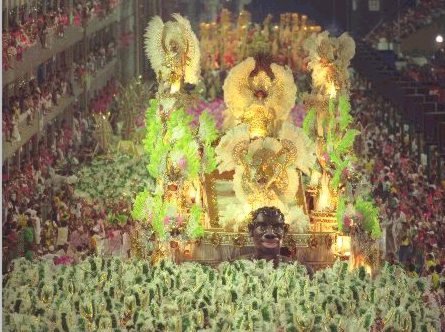
 Each samba school has its own
colors and a flag. The colors of Mangueira, the most famous samba
school in Rio, are green and pink.
Each samba school has its own
colors and a flag. The colors of Mangueira, the most famous samba
school in Rio, are green and pink.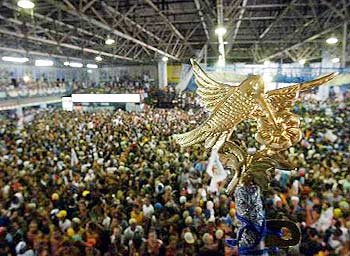
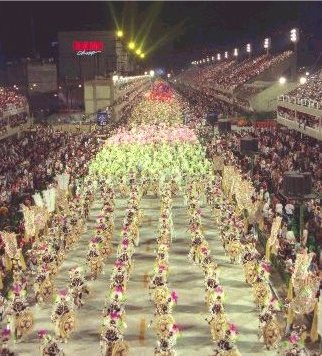
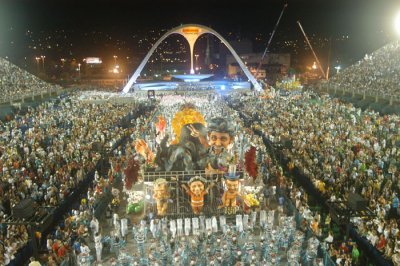
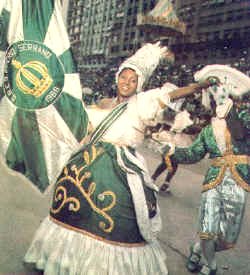
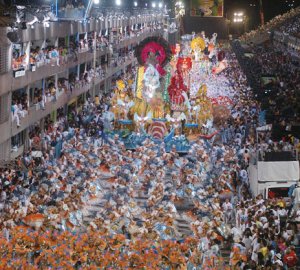
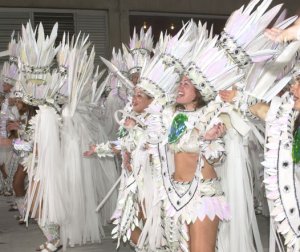
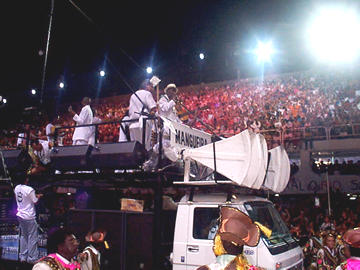
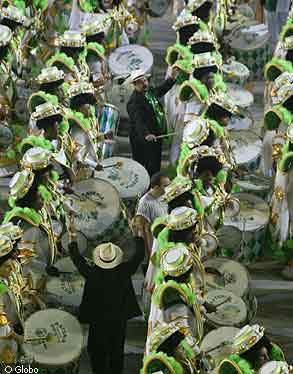
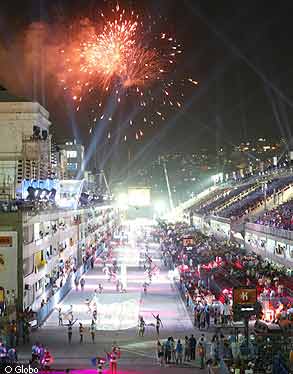
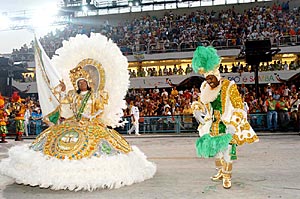
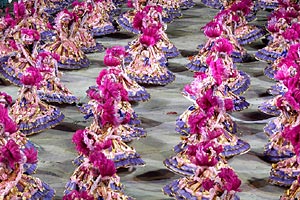
 The baianas are
typical figures of Bahia. A baiana is how a woman from Bahia
(a state in northern Brazil) is called. A typical baiana always
wears a white dress and a turbant on special occasions or festivities.
They are represented in all samba schools in Rio by women on
baiana outfits, which are created accordingly to the theme of
the school.
The baianas are
typical figures of Bahia. A baiana is how a woman from Bahia
(a state in northern Brazil) is called. A typical baiana always
wears a white dress and a turbant on special occasions or festivities.
They are represented in all samba schools in Rio by women on
baiana outfits, which are created accordingly to the theme of
the school.